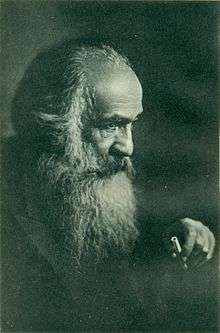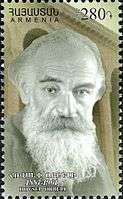Joseph Orbeli
| Joseph Orbeli | |
|---|---|
 Joseph Orbeli | |
| Born |
20 March 1887 Kutaisi, Russian Empire |
| Died |
2 February 1961 (aged 73) Leningrad, Soviet Union |
| Awards |
Order of Lenin (2) Order of the Red Banner of Labour (2) |
| Academic background | |
| Alma mater | St. Petersburg University |
| Influences | Nicholas Adontz, Vasily Bartold, Ivane Javakhishvili, Nicholas Marr, Michael Rostovtzeff |
| Academic work | |
| Discipline | Armenian studies, Iranian Studies, Oriental Studies |
| Institutions | Armenian Academy of Sciences |
| Doctoral students | Aram Ter-Ghevondyan |
| Influenced | Hrach Bartikyan, Aram Ter-Ghevondyan, Karen Yuzbashyan |
Joseph Orbeli (Armenian: Հովսեփ Աբգարի Օրբելի, Hovsep Abgari Orbeli; Russian: Иосиф Абгарович Орбели, Iosif Abgarovich Orbeli; 20 March (O.S. 8 March) 1887 – 2 February 1961) was a renowned Soviet orientalist and academician, who specialized in medieval history of Southern Caucasus and administered the State Hermitage Museum in Leningrad from 1934 to 1951. Of Armenian descent, he was the founder and first president of the Armenian Academy of Sciences (1943–47).[1]
Biography
Early life and education
Born into a medieval noble family in Kutaisi, Russian Georgia in 1887, Joseph Orbeli completed his secondary education at a classical gymnasium in Tiflis.[2] In 1904, he was accepted to St. Petersburg University. He studied history and philology (with a particular emphasis in Latin and Greek) and graduated from the university in 1911. During his student years, Orbeli accompanied his professor, Nicholas Marr, to Russian Armenia, where he took part in excavations of the ruins of the medieval Armenian capital of Ani.[1] Marr pushed his pupil to fully immerse himself in the fields of archaeology, literature, lithography and linguistics; otherwise, Marr reasoned, he would find himself unprepared in his research and his studies.[2]
Archaeological studies
Following his graduation, Orbeli departed for Armenia once more. He became the director of an on-site museum that was established at Ani and, during Marr's absences, frequently headed the excavations himself.[2] He also traveled to Nagorno-Karabakh (more precisely, to the historical region of Khachen), gathering and categorizing lithographic material. Orbeli also managed to travel to Turkish Armenia, where he was able to study Armenian, Seljuk, and Urartian monuments and conduct research on Armenian and Kurdish dialects.
Gradually, Orbeli was emerging as the leading authority on Armenian antiquities in the world. In 1912, he became a member of the Imperial Russian Archaeological Society and in 1914, he began teaching Armenian and Kurdish studies at Saint Petersburg University. In 1916, he participated in a Russian archaeological expedition around the Lake Van region; it was here where he discovered an inscription attributed to the Urartian king Sardur II.[2] He continued his work at St. Petersburg University (in 1917, he was appointed an assistant professor of Armenian-Georgian studies), but occasionally taught at Moscow's Lazarev Institute of Oriental Languages as well. In the years leading up to the Russian Revolution, Orbeli published a number of books, including a catalogue of artifacts found at Ani and a series of studies dealing with classical philology, Armenian history, archaeology and art.[2]
Academic work
This led to his appointment to the Hermitage Museum in July 1934,[3] which he would steer through the hardships of Joseph Stalin's purges. In December 1941, the deadliest month of the Siege of Leningrad, Orbeli led a festival dedicated to Ali-Shir Nava'i, a medieval Turkic poet and philosopher.[4][5] Orbeli considerably enhanced the museum's holdings of Oriental art, making it one of the top Oriental art museums in the world. No less important was Orbeli's role as head of the national school of Caucasus studies. Orbeli underscored the importance of linguistic studies for proper understanding of historical processes.
In 1934, as a member of the Soviet delegation, he went to Iran for the celebrations to mark the 1000th anniversary of the birth of Persian poet Ferdowsi and visited the cities of Tehran and Mashhad.[6] A year later he organised the 3rd International Congress of Iranian Art and Archeology at the Hermitage and the accompanying exhibition therein.[7] The other spiritus movens of the congress was Arthur Upham Pope.
In 1955–60, he was in charge of the Faculty of Oriental Studies at the Leningrad University.
Later life
He was buried at Bogoslovskoe Cemetery in Leningrad.
In art
-
Joseph Orbeli's grave in Saint Petersburg
-
Bust of Orbeli by Levon Konstantinovich Lazarev, 1963
-

Joseph Orbeli on an Armenian stamp, 2012
References
- 1 2 (Armenian) Yuzbashyan, Karen «Օրբելի, Հովսեփ Աբգարի» [Orbeli, Hovsep Abgari] Armenian Soviet Encyclopedia. Yerevan: Armenian Academy of Sciences, 1986, vol. 12, pp. 584–585.
- 1 2 3 4 5 (Armenian) Anon. "Հովսեփ Օրբելի" [Hovsep Orbeli]. Patma-Banasirakan Handes 12/1 (1961), pp. 229–234.
- ↑ Strube V. V. (red). Issledovaniia po istorii kul'tury narodov Bostoka: sbornik v chest' akademika I. A. Orbeli. Moskva Leningrad. Izdatel'stvo Akademiii Nauk SSSR, 1960, p. 9
- ↑ Harrison Salisbury (2003). The 900 Days: The Siege Of Leningrad. Da Capo Press. p. 430.
- ↑ Grigol Ubiria (2015). Soviet Nation-Building in Central Asia: The Making of the Kazakh and Uzbek Nations. Routledge. p. 232.
- ↑ Strube V. V. (1960), p. 9
- ↑ article on an exhibition in the Hermitage organised in 2015 to mark the 80th anniversary of the congress
Select bibliography
- (Russian) Избранные Труды [Selected works]. Yerevan: Armenian Academy of Sciences, 1963.
- (Russian) "Akademik Iosif Abgarovich Orbeli: (biograficheskiy ocherk" [The academician Joseph Abgarovich Orbeli: a biographical essay], pp. [5]-12 in: Strube V. V. (red). Issledovaniia po istorii kul'tury narodov Bostoka: sbornik v chest' akademika I. A. Orbeli. Moskva Leningrad. Izdatel'stvo Akademiii Nauk SSSR, 1960, 527 p.
Further reading
| Wikimedia Commons has media related to Joseph Orbeli. |
- (Armenian) Yuzbashyan, Karen. Ակադեմիկոս Հովսեփ Աբգարի Օրբելի [Academician Hovsep Abgari Orbeli] Yerevan: Armenian Academy of Sciences, 1987.
|
−